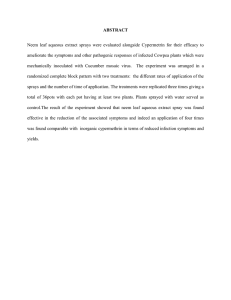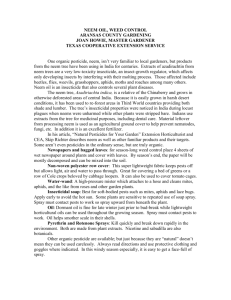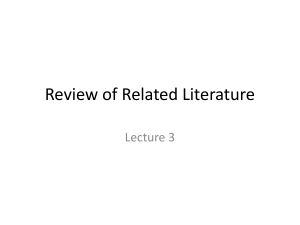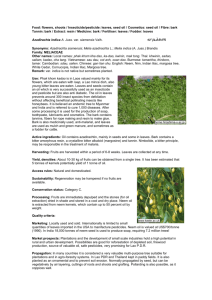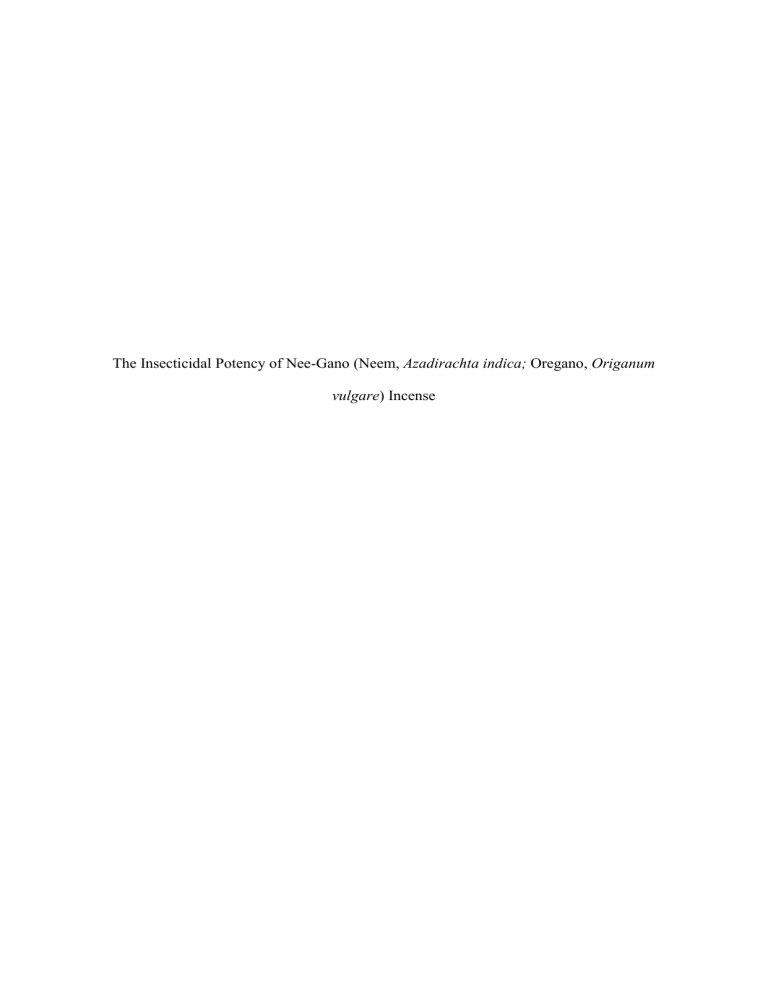
The Insecticidal Potency of Nee-Gano (Neem, Azadirachta indica; Oregano, Origanum vulgare) Incense RESEARCH PLAN Rationale The present study is conducted to test the Insecticidal Potency of Nee-Gano (Neem, Azadirachta indica; Oregano, Origanum vulgare) Incense. Insecticidal compounds can be isolated from potential plant sources through the assessment of insecticide activity against mosquitoes. Results showed that the Nee-Gano (Neem, Azadirachta indica; Oregano, Origanum vulgare) leaf extract were potent against the mosquitoes. It indicated that bioactive components are present in these plants that could be accounted for its insecticidal effects. Thus, the results support the uses of these plant species in traditional practices. A. QUESTION OR PROBLEM ADDRESSED The general objective of this study is to determine the Insecticidal Potency of Nee-Gano (Neem, Azadirachta indica; Oregano, Origanum vulgare) Incense. Specifically, it will aim to answer the following question: 1. What are the number of mosquito deaths of the experimental and control groups posttest? 2. Is the Nee-Gano (Neem, Azadirachta indica; Oregano, Origanum vulgare) leaf and leaf extract potent as an insecticidal agent in terms of the number of the mosquito deaths? 3. Is there a statistically significant difference between the experimental groups and the control groups in terms of the number of mosquito deaths? 2 B. GOALS/EXPECTED OUTCOMES/HYPOTHESIS The hypotheses will be tested for further analysis of the data to answer major problems: 1. The expected number of the mosquito deaths of the experimental and control groups post-test were not attained. 2. The Nee-Gano (Neem, Azadirachta indica; Oregano, Origanum vulgare) extract is not effective as an insecticidal agent in terms of the number of mosquito deaths. 3. There is no statistically significant difference between the experimental groups in terms of the number of mosquito deaths. C. DESCRIPTION IN DETAIL OF METHODS/PROCEDURES PROCEDURES Reagents, Tools, and Equipment All chemicals and solvents, denatured alcohol, will be procured from the Chemical Laboratory of Santa Cruz Academy, Inc. Junior High School Department. Tools and equipment will be used with permission from the institution. Plant Materials The Nee-Gano (Neem, Azadirachta indica; Oregano, Origanum vulgare) leaf and leaf extract will be gathered in the community of Santa Cruz, Zambales. The collected leaves will be extracted and sun-dried. The dried leaves will be pulverized by means of mortar and pestle. Preparation for Neem Leaves 3 Neem leaves will be harvested. Leaves will be removed from the stems, will be sundried / dehydrated using an oven. Using a mortar and pestle, the neem leaves will be pulverized into fine powder and will be stored in a beaker. Preparation for the Oregano Oregano leaves will be harvested. Using an electric juicer, all the extract of the oregano leaves will be removed. All the solid part of the leaves will be collected, will be sundried / dehydrated using an oven. The oregano leaves will be pulverized using a mortar and pestle until it becomes a fine powder and will be stored in a beaker. Preparation of Charcoal Charcoal will pulverized into fine powder using a mortar and pestle and will be stored in a beaker. Preparation of the Candle/Wax Using a grate, candle/wax will be grated into a smaller pieces and will be stored in a small container. 100% Neem Formula Using an electric weighing scale, the following will be weighed: - 30 g. pulverized neem leaves - 8 g. pulverized charcoal - 18 g. starch - 12 g. grated candle In a large beaker, all the measured dry ingredient (30 g. pulverized neem leaves, 8 g. pulverized charcoal, 18 g. starch, and 12 g. grated candle) will be mixed. 30 ml of tap water 4 (put 5 ml of tap water at a time) will be added to achieve desired consistency. A drop of fragrant lavender extract will be added to the mixture. 100% Oregano Formula Using an electric weighing scale, the following will be weighed: - 18 g. starch - 10 g. pulverized oregano leaves - 8 g. grated candle/wax - 8 g. pulverized charcoal In a large beaker, all the measured dry ingredient (10 g. pulverized oregano leaves, 8 g. pulverized charcoal, 18 g. starch, and 8 g. grated candle) will be mixed. 25 ml of oregano extract will be measured using a pipette (measure 5 ml of extract at a time) and will be added to the mixure. Using a pipette, 10 ml of tap water (put 5 ml of tap water at a time) will be added until the desired consistency is achieved. A drop of fragrant lavender extract will be added to the mixture. 50% Neem and 50% Formula The procedures on making the 100% formula of Neem and Oregano will be repeated. Using an electric weighing scale, 20 g. of the 100% neem formula and 20 g of 100% oregano formula will be measured and mixed. 1 ml of tap water will be added continuously until desired consistency is achieved. 75% Neem and 25% Oregano Formula The procedures on making the 100% formula of Neem and Oregano will be repeated. Using an electric weighing scale, 30 g. of the 100% neem formula and 10 g of 100% oregano 5 formula will be measured and mixed. 1 ml of tap water will be added continuously until desired consistency is achieved. 75% Oregano and 25% Neem Formula The procedures on making the 100% formula of Neem and Oregano will be repeated. Using an electric weighing scale, 10 g. of the 100% neem formula and 30 g of 100% oregano formula will be measured and mixed. 1 ml of tap water will be added continuously until desired consistency is achieved. Molding The mixture will molded and compressed on a plastic straw.. The mixture will be compressed using a large stirring rod or chopsticks. When the mixture is finally compressed, it will be separated from the straw using the stirring rod or chopsticks. The molded mixture will then be put in an aluminum foil. Cooking the Molded Mixture After laying the mixture in the aluminium foil, the mixture will be heated in an oven for 10 minutes (cook every 5 minutes then stop) After cooking the mosquito sticks, it will be sun-dried until the sticks harden. Collecting of Mosquito Larvae The mosquito larvae will be gathered using a syringe without the needle. The collected larvae will be fed with two grams of fish food in each day and will be observed until they turn into mosquitoes. Feeding of the Mosquito 6 The mosquitoes will fed by water-sugar formula. The cotton balls will be soaked into a 1 cup of water mixed with 10 tablespoons of brown sugar. Application of test treatments to the mosquitoes Ten mosquitoes will be hatched from larvae on seven different containers. Test Treatment A to G, A being the negative control, B with 100% Neem, C with 100% Oregano, D with 50-50% Neem and Oregano, E with75-25 Neem-Oregano, F with 25-75% Neem Oregano and G as the positive control. The number of dead mosquitoes will be counted after a period of ten minutes, giving the results in table1. Safety Precautions Personal Protective Equipment (PPS) will be utilized at all times during the research period. A laboratory gown, face mask, eye protecting goggles, and surgical gloves will be worn at all times. Protective clothing, helmets, goggles, or other garments or equipment designed to protect the wearer's body from injury or infection will also be used. Standard laboratory rules and protocols will be followed strictly. All experimental procedures will be performed under the supervision of the research adviser. Disposal of Mosquito All containers which will contain live mosquitoes or once live mosquitoes, will be disposed of in a sealed primary containers. This will prevent the mosquitoes from escaping. All mosquitoes will be terminated before final disposal. The preferred method is to place the insects in a freezer until no longer viable. The bagged and cold-treated mosquito wastes can be disposed of in the same manner as other solid, non-sharp biohazard wastes. 7 DATA ANALYSIS Independent T-test will be used to determine the significant differences of the experimental treatments with the negative and positive control. Meanwhile one-way ANOVA test will performed to determine the statistically significant differences between the experimental groups. A Tukey post hoc test will performed in order to identify which experimental groups have a statistically significant differences with each other. 8
